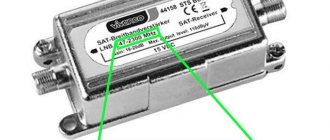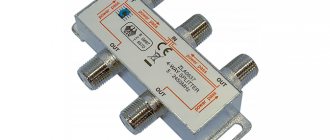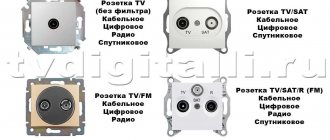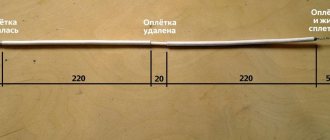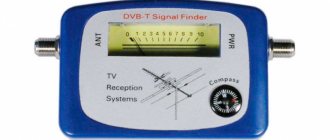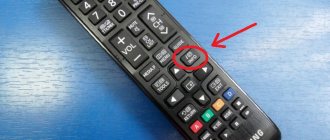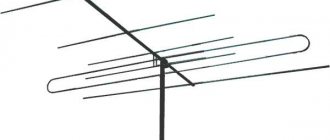In modern Russia there are 2 types of television signals - digital and analog. The latter disappears from the territory of the country in connection with the state program for digitalization of the Russian Federation.
- Why does the TV signal deteriorate?
- Methods for ensuring reliable TV signal reception
- What is an antenna amplifier
- When will an antenna amplifier help?
- Advantages and disadvantages of antenna amplifiers
- How to choose an amplifier
- How to connect an antenna amplifier
- TOP best amplifiers for antennas
Why does the TV signal deteriorate?
The TV signal is distributed from the towers of local branches of the Federal State Unitary Enterprise "Russian Television and Radio Broadcasting Network". In 2018-2019, the unitary enterprise installed additional reinforced concrete supports in cities and villages for digital broadcasting.
Television uses a wide range of frequencies, this is fraught with 2 reasons for the deterioration of the television signal:
- Both digital multiplexes distribute through a single antenna-feeder network, which is more suitable for certain radio frequencies. The channel packages themselves can be broadcast with a significant frequency difference. In this regard, the coverage of one multiplex is noticeably better than another.
- Some receiver configurations may not be suitable for specific frequencies. For example, a cheap Polish antenna purchased may not pick up a digital signal due to the incorrect length of the pins on the array.
In addition to the above reasons, deterioration of the television signal can occur due to:
- Obstructions between the receiver and transmitter. Even capital construction projects or terrain can become a potential obstacle.
- Malfunctions of the receiving equipment - broken cable, damaged antenna array, burnt amplifier or TV connector.
- Disabling a previously operating transmitter. Over the past year, Russian regions have almost completely switched off analogue television broadcast transmitters.
- Transmitter maintenance.
- Interference - this happens extremely rarely. If you suspect interference, write a statement to the nearest branch of the territorial Office of Roskomnadzor. Department specialists must respond to it and take measures to eliminate the problem.
- Incorrect azimuth of the directional antenna array.
FSUE "RTRS" separately transmits sound and picture for an analog television signal. Digital multiplexes transmit using a single spectrum.
Some of these problems can be solved without spending money - by correctly rotating the antenna or contacting the federal service. If there is no reception due to a weak TV signal, a properly selected amplifier will help.
Locus Meridian-12F
Cheap outdoor antenna, ideal for cottages in moderate broadcast areas. Having a weak gain - all 9 dB - it produces a good picture, while suppressing most interference. The manufacturer recommends a radius of about 25 km, otherwise the signal will drop noticeably.
Its main advantage is its unpretentiousness. The amplifier is covered with a moisture-resistant casing, which allows it not to be covered during rain.
Advantages:
- An excellent and inexpensive option for a TV for the country.
- Good picture quality in the coverage area.
- Easy installation and complete kit out of the box.
Flaws:
- Short cable included.
- The quality of the fastening is mediocre, even though it is metal.
Methods for ensuring reliable TV signal reception
To ensure reliable signal reception, you need to find the reason for its loss. For this:
- To rule out a malfunction of the receiving equipment, try receiving a package of channels through another system, for example, a neighbor’s.
- Find the correct direction to the transmitter. To do this, turn the antenna and at the same time look at changes in the signal level on the TV - even old ones will show you the necessary data in scanning mode.
- Replace the nodes from the TV to the antenna one by one. Start with the cheapest and easiest to install.
In rare cases, the reflected signal is stronger than the direct one, for example, when a radio wave is reflected from an object that is located significantly above the receiving antenna, but is directed towards it.
When the reasons are clear, all that remains is to eliminate them:
- if an element of the receiving equipment is faulty, replace it;
- if the directional antenna is incorrectly directed, change its position;
- if the signal level from the transmitter is not enough, raise the receiving antenna array higher and install an amplifier.
An amplifier can amplify not only radio waves, but also ambient radio noise or interference.
Sometimes, to obtain a high-quality signal, it is enough to replace a cheap Polish antenna with a modern, efficient “delta”. An expensive passive antenna will probably receive much more useful signal under the same conditions. For a more detailed list of certified antennas suitable for receiving digital packets, see the link.
Godigital AV 6520
An inexpensive antenna for digital TV, which is good in the country. In general, its characteristics are not bad: gain 45 dB, good noise amplification, high moisture protection.
True, she has enough problems. So, despite the good gain, it does not catch well at a distance of 60-70 km from the repeater. In addition, sometimes the injector cable is not included in the kit.
Power is supplied via a coaxial cable, which already indicates some “fakeness” of the amplifier. But the assembly is strong: nothing cracks or breaks. The antenna is fixed to the mast, and firmly - it is not afraid of wind and snow.
Advantages:
- Low price. Therefore, this is a good digital TV receiver for the dacha - the price is only 1,600 rubles.
- High degree of moisture protection.
- Power adjustment is provided.
Flaws:
- Mediocre amplifier.
- The warranty is only 1 month.
What is an antenna amplifier
An antenna amplifier is a device whose purpose is to amplify only the useful signal. The device itself should not make “noise” on the air or raise the level of third-party noise.
Depending on the functionality of the device, there are 3 types:
- A universal amplifier that receives meter and decimeter radio waves throughout the entire television spectrum.
- A local amplifier that works only for a certain frequency range. For example, in 2021, it is relevant to purchase equipment only for DVB-T2 digital multiplexes.
- A device that receives several operating radio frequency bands.
Based on their installation location, amplifiers are divided into mast-mounted and cable-mounted. The former are better at amplifying, but the latter are more convenient, since they are always in sight and within walking distance for people.
The best antennas: budget, with top quality for NTV+ and Tricolor TV
We have identified 3 more separate nominations for the best antennas.
The best budget model is DEXP G-090
It is unlikely that you will be able to find a cheaper antenna. This is a compact black model for indoor use. It has all-wave reception in VHF and UHF.
Price: 300-400 rubles.
DEXP G-090
Antenna with the best signal quality – TV Future Indoor DVB-T2
There may be antennas with even better quality, but they are very expensive. This model is inexpensive, comes with a receiver and provides high picture quality. It has an amplifier for receiving the signal and transmitting it to the TV. The kit includes: fastenings, cable, control panel, tuner (model TVjet RE820HDT2) with antenna.
Price: 2500-2700 rubles.
TV Future Indoor DVB-T2
When will an antenna amplifier help?
An antenna amplifier will help if the channels are not shown, because the level of radiation from TV transmitters is consistently low at the location where the antenna is installed. This happens because:
- employees of the transmission center use a transmission device of insufficient power;
- there are obstacles in the path of the radio wave, and the level drops significantly;
- you are too far from any TV tower.
It is useless to boost a TV signal if you have not positioned the antenna correctly, are using faulty equipment, or are being interfered with by another transmitter. If there is interference, broadband amplification will not only not help, but will also worsen the electromagnetic background.
Equipment Needs
The main task: to minimize cable losses. If the antenna itself does not have enough strength to catch the moving flow, then the microcircuit will not help. The need for a receiver arises if there is a sufficiently large distance between the device and the TV. The abilities will be fully revealed if there is a distance of 30 meters or more. Whatever the cable, the signal weakens as it passes through. You can also purchase a device when reception is from a weak repeater.
Options when there is no need to purchase a product:
- The incoming signal will have a power several times greater than the required value.
- In addition to television channels, the receiver picks up extraneous noise.
- Critical level of reception.
Before proceeding with installation, you must consider the following nuances:
- Availability of power supply. The product is sold simultaneously with the power supply. But there are also exceptions. There is no need if a voltage of 5 V is required. Then you can borrow electricity directly from the tuner. The current flow will be of high quality, there will be no ripple. However, many models require 12 V.
- There is a possibility of burnout when struck by lightning. To reduce the possibility of a negative outcome, lightning protection or grounding is done.
- Time passes and the power supply begins to deteriorate. In this case, the quality of the received signal decreases.
- It becomes possible to enhance the reception of a third-party signal, thereby reducing the quality of the TV channel.
Advantages and disadvantages of antenna amplifiers
Lists the pros and cons of using amplifying television equipment in a table.
Advantages and disadvantages of TV amplifiers
| Advantages | Flaws |
| Improving the quality of received analog and digital channels | Multiple amplifiers can interfere with each other, distorting the resulting picture or sound |
| Reception even in remote areas and behind obstacles | Broadband amplification units increase the level of all radio waves. If any of these waves turns out to be too strong, the input stage will be overloaded and the receiver will temporarily fail. |
| Compact body | High price of individual models |
| Ability to customize the device as you use it |
One For All SV9345
An excellent digital television receiver operating in two bands. In both, it produces 43 dB of gain, so it is safely suitable for areas remote from the repeater.
The model is made in an interesting plastic case, with a moisture protection index of IP 55.
Advantages:
- Long cable included.
- Reliable fixation to the wall (fasteners and mast come with antenna).
- Good noise damper.
No deficiencies were found.
How to choose an amplifier
It is better to choose a strengthening technique based on your situation. Consider what antenna is installed, what channels you want to receive, and what kind of terrain surrounds you.
You can find out the frequencies to receive the channels you need on the Internet. They differ for different cities and regions.
By gain
Gain is a universal value measured in decibels (dB).
A decibel is a relative value that shows how many times the signal has changed. It is used to describe the characteristics of antenna arrays and amplifying devices. For example, a 3 dB difference in the levels of 2 signals means that one is 2 times more powerful than the other, 10 dB is 10 times more powerful, and 20 dB is 100 times more powerful.
If the distance to the nearest TV tower exceeds 30 km, do not be afraid to overdo it with the CG indicator - the more, the better.
If there are 15-30 km between the receiver and the television transmitter, the main thing is not to overdo it with the control panel. Too strong a signal will have the opposite effect and the channels will show better without an amplifier than with one.
At the installation location
As we wrote, there are 2 of them:
- On the roof, at the exit from the antenna. In this case, the signal level is first raised and then transmitted to you via wire. The result is better, but if you want to correct this process, you will have to go to the transmitter. Nothing compensates for losses in the cable.
- When coming out of the cable near the TV. In this case, the device amplifies what has already come to the TV. The process is easy to control and adjust, but the capabilities of the amplifier will be less than when used externally.
As a result, you will have to choose between increased quality and convenience.
Active or passive
Passive and active antenna arrays are used to receive radio waves. The latter are distinguished by a built-in amplifier, which is already matched in characteristics to the antenna.
If you are using an active reception system, then purchasing another amplifier will only be necessary for very difficult reception conditions, when there is not a single TV tower within a radius of 30 km or more.
If you decide to buy a separate amplifying device for an active antenna, keep in mind that the built-in and external amplifiers may interfere with each other. Buy devices with the most similar characteristics.
By frequency range
Decide what exactly you want to receive from the TV tower. There are several options:
- digital signal of the DVB-T2 standard with 2 multiplexes of 10-12 channels each;
- analog signal using decimeter waves;
- analog signal using meter waves.
Meter waves propagate at radio frequencies of 30-300 MHz, and decimeter waves - 300 MHz-3 GHz, but for TV they are not used above 862 MHz.
Some amplifiers on the market simultaneously support TV and non-TV data standards and connect to multiple devices.
The antenna array consists of a set of pins. For optimal reception, the length of each pin must be a multiple of the wavelength that carries the signal. If everything is done correctly, then the standing wave coefficient for the receiver tends to 1, and you get high-quality picture and sound. Therefore, to receive over a wide range, antenna manufacturers have to install many pins of different lengths on the antenna array - each for its own frequency ratings.
The more local the radio frequency range for which the amplifier and antenna are designed, the greater their sensitivity to the received signal and the less likely they are to be overloaded.
In expensive amplification devices with a wide range of operating frequencies, the device is divided into several subamplifiers, each of which operates with dedicated radio frequencies. Thanks to this, the heat exchanger rises.
By noise figure
When studying various amplification devices, you will find the abbreviation LNA - low noise amplifier. The less noise the device amplifies, the better. Ideally, an exclusively useful signal should remain.
Not all amplifiers are low-noise; when selecting noise figure, it is important to choose a device that will provide an acceptable signal-to-noise ratio. The higher the value, the better.
The final CN value for amplifiers is in the range of 1-3 dB.
By nutrition
Amplifiers require one of two voltages to operate:
- from power source 3-5 V;
- from a 12 V power supply.
The power supply operates through a regular 220 V socket and via a USB connector for indoor versions or a TV cable for a mast version.
One For All Full HD Outdoor
A compact “monster” with a signal amplification of 52 dB, and on two bands. An outdoor antenna for watching 1080p video is one of the best!
Like all antennas from this rating, it works in the decimeter and meter range, with a coefficient of the same at all frequencies. The case is moisture resistant, so it is not afraid of precipitation. A complete mounting kit comes with the receiver.
One For All Full HD Outdoor also comes with a ten-meter cable, so you don’t have to struggle with moving the TV. However, the antenna does not come with a mast for mounting, which is not very convenient, and you will have to purchase it separately.
Advantages:
- The only receiver that provides “honest” 1080p.
- Minimum interference.
- Excellent noise reduction.
- Long cable included.
The only disadvantage is the price - about 7,000 rubles.
How to connect an antenna amplifier
The amplifying device consists of TV input connectors, TV output connectors and a power supply. When receiving energy from a TV cable or USB connector, there is no power supply in the circuit. To start the system:
- Connect the antenna cable to the amplifier input.
- Connect one or more televisions to the outputs of your amplification equipment.
- If necessary, insert the power plug into the outlet.
- If your device has a gain control, use it. To select the optimal settings, adjust them while watching TV.
Watch the video to see how to properly crimp new TV cables without special tools or outside help.
Review of popular models
Some amplifiers are in demand due to their simple design, low cost and easy installation. If necessary, the devices can be installed, replaced or repaired yourself.
Image gallery
Photo from
EUROSKY SWA-555
Planar 21-69FT
Locus LA-21
Terra 126
When purchasing devices for external use, take care of their tightness. It has been noted that external devices have to be replaced approximately once every 2 years, despite their protection, so if it is possible to install the amplifier under the roof, take advantage of it.
Amplifier circuits
The rest of the article provides examples of TV signal amplifier circuits.
The first scheme is one of the simplest options, suitable for a broadband antenna.
The second option is more complicated, but you can make it yourself at home.
Final scheme. The most difficult, but only at first glance.
If you understand it, then there will be no problems making it at home.
We make a universal amplifying device
Amplifier parameters:
- Frequency ranges: 50 MHz - 4000 MHz;
- Gain: 22.8 dB - 144 MHz, 20.5 dB - 432 MHz, 12.1 dB - 1296 MHz;
- NR: 0.6 dB - 144 MHz, 0.65 dB - 432 MHz, 0.8 dB - 1296 MHz;
- Electrical current consumption is approximately 25 mA.
Amplifier circuit:
To make an amplifier you will need an RFMD SPF5043Z circuit. You can buy it on AliExpress.
Below is an example of an amplification device board.
Foil-coated PCB is suitable for making the board. Etching the latter can be omitted
A rectangular hole with dimensions of about 0.15×0.20 cm is cut out in a double-sided foil PCB.
Next, using a metal marker, outline the wiring itself in size.
Then the tracks can be etched or mechanically cut.
Then we tin everything using a soldering iron and solder SMD components, size 0603. To shield the substrate, we short the foil on the bottom side of the board to a common cable.
You don't need to make any settings. Alternatively, you can measure the input voltage, which should be approximately 3.3 volts, and the current ≈ 25 mA. When working with a range greater than 1 GHz, it may be necessary to match the input circuit. To do this, you will have to reduce the capacitor to 9 pF. Next you need to connect the board to the TV antenna.
Connects the board to the antenna. Checking the board confirms normal gain and low noise levels.
It is recommended to place the board in a shielded case, as shown below.
The finished board for the amplifying device is sold on AliExpress. But its main disadvantage is that the cost is much higher than that of a homemade one. Therefore, it is better to spend time and make it yourself.
The circuit is powered by a voltage of 3.3 volts. This option is not very convenient, for example, when using an amplifier in a car whose on-board network is 12 volts.
The stabilizer in the circuit allows you to solve this problem.
The amplifying device should be located as close as possible to the antenna.
A loop or frame vibrator will help protect your device from static electricity and thunderstorms.
Antennas of apartment buildings
If the service company works normally, then residents of apartment buildings do not have to think about amplifying devices for TV signals. Such devices, with normal maintenance, function well and without complaints. When the signal from the common antenna is rather weak, or there is none at all, then there is no need to rush into purchasing or manufacturing such devices. To begin with, it is better to call the service organization and tell about such malfunctions.
After the call, specialists arrive, inspect the antenna and decide what to do with it - repair or replace.
Important! Household TV signal amplification devices will always be many times more powerful than any individual, and even more so home-made option.
